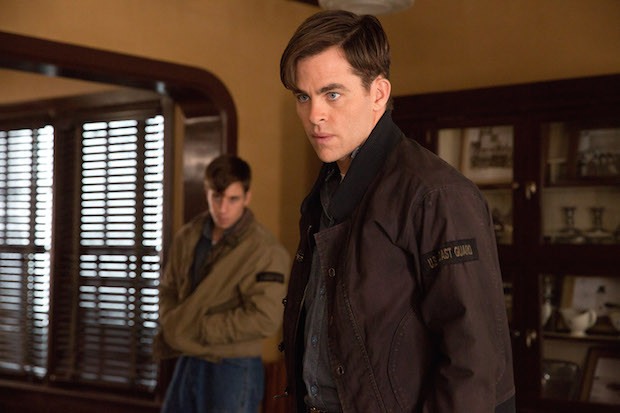Disney’s The Finest Hours (Maggie’s Review)
Editors Note: Today we welcome a new guest contributor to disneygeek.com. Maggie will be checking in from time to time with movie reviews and more from Southern California.
Disney’s The Finest Hours opens in theaters nationwide on Friday, Jan. 29. I had the opportunity to see it on Tuesday evening in Hollywood.
The Story:
The Finest Hours is a daring rescue movie based on real events occurring on February 18, 1952. While a massive storm wallops New England, U.S. Coast Guard Captain Bernie Webber (Chris Pine) is tasked to rescue the crew members of an oil tanker cleaved in two by the storm. The crew, led by Ray Sybert (Casey Affleck) is forced to escalating means in order to keep the remnants of the SS Pendleton afloat, while awaiting a rescue mission that may never come. On shore, Webber is awaited by his fiancée, Miriam (Holliday Grainger).

The Setting:
The Finest Hours plays out in Chatham, Massachusetts and its surrounding waters. On land scenes are composed of loving shots of the landscape and period of post-war New England. The movie opens on a snowy lane outside of a sparsely populated diner, before moving to a worn seaside bar and eventually a boisterous dance hall. The bulk of the on-land action occurs in the Coast Guard station in Chatham and was shot in the same station where Webber was given the assignment in 1952.

“We had always hoped to film this picture in New England where the events actually took place,” said producer Dorothy Aufiero. “Being able to visit the historic sites where Bernie Webber and his crew did their jobs was an extraordinary experience for everyone involved.”
Producer Jim Whitaker added, “With the size and scope of a story like this, it is important to counterbalance the emotionality of the humanity, so the actors needed to be in an authentic environment for it to feel real both for them and the audience.”
These thematic shots are juxtaposed with scenes in the belly of the SS Pendleton. While there are no remaining T2 tankers like the Pendleton and many scenes were shot on massive set recreations of the engine room, some of the scenes on the ship were shot on a decommissioned Cold War-era heavy cruiser in Quincy, Massachusetts.

The most harrowing shots of the film, Webber piloting a lifeboat through 60-foot waves in near hurricane conditions, were predominantly filmed using an 800,000 gallon tank and movie magic. However, nearly a third of the film’s water scenes were actually shot on open water.
My Thoughts:
While The Finest Hours is an engaging film that fulfills its purpose, the storytelling is admittedly clunky and the character development a bit ham-handed. Webber is established early and often to be insecure in himself and his abilities, and generally weak willed. His adherence to rules is brought up explicitly multiple times so that the audience could not possibly miss the significance when he goes against regulation. Webber’s relationship with Miriam is developed hastily, and her continued appearance in the movie serves only to tether the action to land. On the SS Pendleton, Sybert acts as a near overlapping parallel character to Webber. Sybert is also established early as quiet and unassuming. Though unafraid to assert his technical expertise, he, like Webber, is a reluctant leader.

Despite its flaws, The Finest Hours is still riveting and atmospheric. Scenes of the slow destruction of the SS Pendleton are tense and jarring. The many shots of Webber and his crew navigating through the storm in a deluge of rain and icy waves convey the gravity and seeming hopelessness of the their rescue mission. The action sequences of the lifeboat crashing through waves and the eventual transfer of the SS Pendleton crew achieve a surprising coherence, and utilize unique angles to break up repeated actions.
Overall, while not the most artfully crafted story, The Finest Hours is a quality historical movie whose imagery and atmosphere definitely takes advantage of 3D beyond the usual and is worth a watch.


